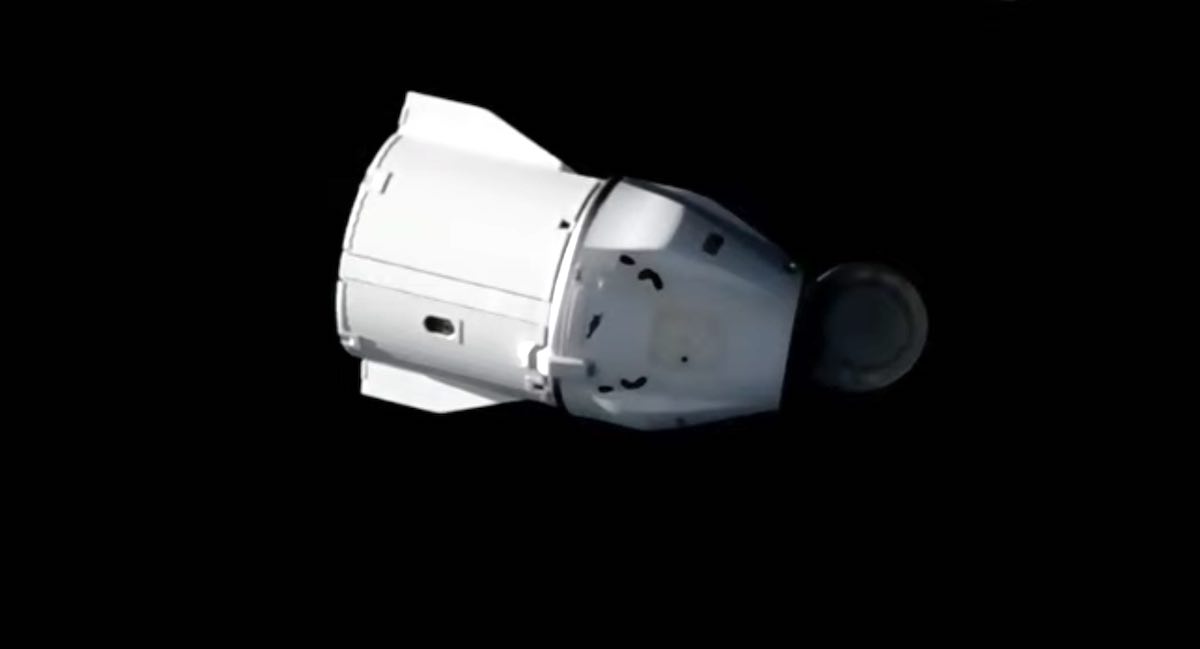
SpaceX’s Cargo Dragon spacecraft, closing out a month-long mission, undocked from the International Space Station Sunday after a two-delay in its departure to wait for better weather in the capsule’s recovery zone off the coast of Florida.
The gumdrop-shaped cargo freighter undocked from the station’s Harmony module at 10:40 a.m. EDT (1540 GMT) Sunday. A series of departure maneuvers using the ship’s Draco thrusters guided Dragon away from the complex, setting up for a deorbit burn at 3:18 p.m. EDT (2018 GMT) Monday to allow the spacecraft to drop out of orbit and re-enter the atmosphere.
Splashdown in the Gulf of Mexico off the coast of Panama City, Florida, is scheduled for around 4:05 p.m. EDT (2105 GMT) Monday. Four main parachutes will slow the capsule before reaching the ocean, where a SpaceX recovery vessel will be in position to raise the Dragon spacecraft from the sea.
Time-sensitive cargo, such as biological research samples, will be flown back to Kennedy Space Center by helicopter, where NASA researchers will receive and catalog the materials for analysis and distribution to scientists around the world.
The undocking and splashdown will complete SpaceX’s 24th resupply mission to the space station since 2012 under the umbrella of two multibillion-dollar commercial contracts with NASA.
The Dragon spacecraft is packed with more than 4,900 pounds (2,200 kilograms) of cargo, including a spacesuit coming back to Earth for refurbishment after supporting spacewalks outside the space station.
The mission launched Dec. 21 from NASA’s Kennedy Space Center in Florida atop a Falcon 9 rocket. The Dragon cargo freighter docked with the space station Dec. 22, and astronauts began unpacking science experiments, holiday gifts and food, spare parts and other supplies.
The cargo delivery last month hauled 6,590 pounds (2,989 kilograms) of supplies and experiments, including packaging, to the space station’s seven-person crew.
The Dragon cargo ship delivered four experimental CubeSats to the station from teams at Kennedy Space Center, Aerospace Corp., Utah State University, and Georgia Tech. The CubeSats will be robotically deployed outside the complex later this year.
The scientific experiments launched on the SpaceX cargo freighter included an investigation from Merck Research Labs studying monoclonal antibodies. The research focus of that experiment is on analyzing the structure and behavior of a monoclonal antibody used in a drug aimed at treating cancers.
Another experiment is assessing the loss of immune protection in astronauts flying in space.
Proctor & Gamble and NASA have partnered in another experiment to test the performance of a new fully degradable detergent named Tide Infinity, a product specifically designed for use in space.
Astronauts on the space station currently wear an item of clothing several times, then discard the garment. But crews flying to the moon and Mars won’t have the same supply chain of cargo missions to support them.
NASA says Tide plans to use the new cleaning detergent to “advance sustainable, low-resource-use laundry solutions on Earth.”
Another research investigation will test manufacturing methods for superalloys in space. Alloys, materials made up of a metal and at least one other chemical element, could be produced in microgravity with fewer defects and better mechanical properties, according to NASA.
“These superior materials could improve the performance of turbine engines in industries such as aerospace and power generation on Earth,” NASA said.
Two research pallets from the U.S. military’s Space Test Program rode to the space station inside the Dragon spacecraft’s unpressurized trunk. The two payloads, named STP-H7 and STP-H8, were transferred from the Dragon spacecraft to mounting points outside the space station using the lab’s robotic arm.
The STP-H7 payload package was mounted outside the European Space Agency’s Columbus lab module. STP-H8 was placed on the exposed science facility outside the Japanese Kibo lab.
Two weather instruments from NASA’s Jet Propulsion Laboratory are hosted on the STP-H8 experiment package.
With its 32-day stay at the station over, the astronauts on the research outpost replaced the cargo delivered by Dragon with materials tagged for return to Earth.
Email the author.
Follow Stephen Clark on Twitter: @StephenClark1.
